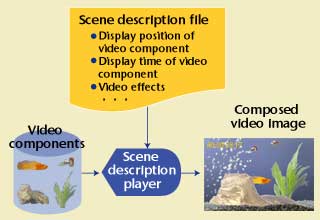 |
Kazuhisa IGUCHI,
Research Engineer,
Advanced Audio &
Video Coding |
I have been with NHK Science and Technical Research Laboratories since 1993. My research interest is image processing. I have been engaged in research on motion vector estimation and motion compensation for video standard conversion and object-based image processing. Since 1999, my research interest is scene description language. Existing scene description languages are principally for scene presentation to users. For reason of efficient program production, I think it is useful to apply scene description language to broadcast program production. If a standardized scene description language independent of specific hardware can be used in program production, it is possible for editors and studios to collaborate and easily modify or reuse existing image scenes. |
The digitalization of broadcasting increases the
availability of channels and the spread of the Internet is driving
demand for a wider variety of programming. STRL is developing
efficient program production technologies that can produce quality
programs in a fraction the time and cost of conventional production
systems. As part of this research, we developed a scene description
language called media object interlock and synthesis (MIKSS for
short and pronounced 'mix') that can describe the functions used
in image composition, video effects creation, and editing. The
development of this language was based on an examination of the
functions needed for video production.
The objects comprising a video scene, such as people and the background,
are called video components. In addition to indicating the display
position and time for each component, MIKSS makes it easy to describe
the video production functions. These functions include the video
editing processes, using an "IN" point (the starting point of
a video sequence) and an "OUT" point (the completion point of
a video sequence), the scene change processes (switching of a
video) such as wipe and dissolve (switching of a video by overlapping
it with another), and the video effects processes, including color
conversion and transformation. The language can also be used to
describe interactive video scenes, providing additional video
information whenever a user clicks a mouse or takes some other
action.
 |
| Figure 1: Video composition by scene
description |
Figure 1 shows an example of video production using MIKSS. Moving
images, such as the fish and water plants of the figure, are the
video components. First, a scene description file containing the
video-component display positions and times is created. This file
is read by a scene description player, which displays a video
scene containing the described video components. The video image
can be easily modified, for example, replacing a video component
or moving a display position, by rewriting the MIKSS scene description
file.
Figure 2 shows a conceptual diagram of a video production system
in which video components are shared on a network. Each area enclosed
by broken lines comprises one editing system. The common scene
description language allows a producer to edit on any editing
system, as long as he or she has the scene description file. Since
a scene description file can be created on a simplified editing
system that handles only textual data, the costs for program production
facilities can be reduced.
Future improvements to the language will include adding functions
for video production via networks and making the video scenes
described by MIKSS available for use in data broadcasting and
on the Internet.
 |
| Figure 2: Video production system using scene description language |
|

